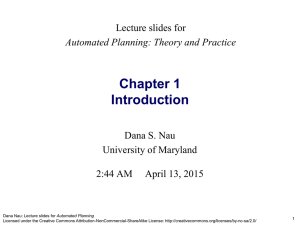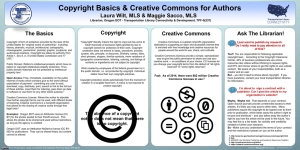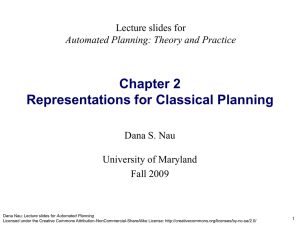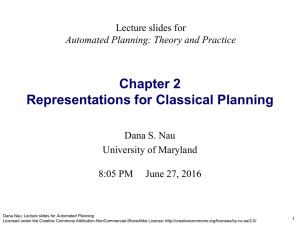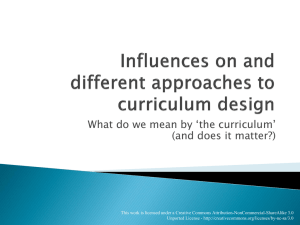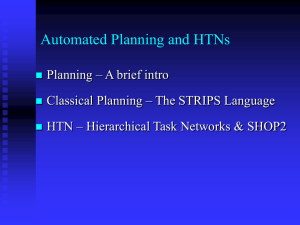ppt - Computer Science Department
advertisement
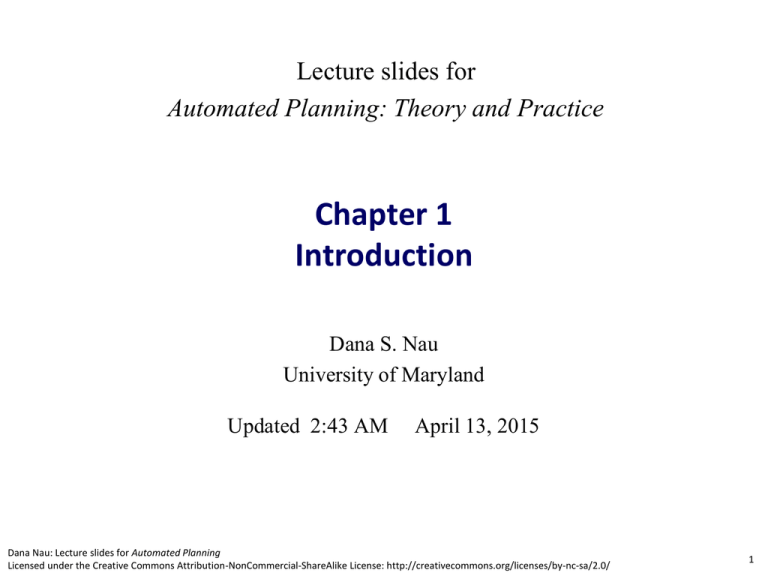
Lecture slides for
Automated Planning: Theory and Practice
Chapter 1
Introduction
Dana S. Nau
University of Maryland
Updated 2:43 AM
April 13, 2015
Dana Nau: Lecture slides for Automated Planning
Licensed under the Creative Commons Attribution-NonCommercial-ShareAlike License: http://creativecommons.org/licenses/by-nc-sa/2.0/
1
Some Dictionary Definitions of “Plan”
plan n.
1. A scheme, program, or method
worked out beforehand for the
accomplishment of an objective:
a plan of attack.
2. A proposed or tentative project or
course of action: had no plans for
the evening.
3. A systematic arrangement of
elements or important parts; a
configuration or outline: a seating
plan; the plan of a story.
4. A drawing or diagram made to
scale showing the structure or
arrangement of something.
5. A program or policy stipulating a
service or benefit: a pension plan.
[a representation] of future behavior …
usually a set of actions, with temporal
and other constraints on them, for
execution by some agent or agents.
– Austin Tate, MIT Encyclopedia of
the Cognitive Sciences, 1999
Dana Nau: Lecture slides for Automated Planning
Licensed under the Creative Commons Attribution-NonCommercial-ShareAlike License: http://creativecommons.org/licenses/by-nc-sa/2.0/
2
Abstraction
Real world is absurdly complex, need to approximate
Only represent what the planner needs to reason about
State transition system = (S,A,E,)
S = {abstract states}
‣ e.g., states might include a robot’s location,
but not its position and orientation
A = {abstract actions}
loc1
‣ e.g., “move robot from loc2 to loc1” may
need complex lower-level implementation
E = {abstract exogenous events}
loc2
‣ Not under the agent’s control
= state transition function
‣ Gives the next state, or possible next states, after an action or event
‣ : S × (A E) S or : S × (A E) 2S
In some cases, avoid ambiguity by writing S, A, E,
Dana Nau: Lecture slides for Automated Planning
Licensed under the Creative Commons Attribution-NonCommercial-ShareAlike License: http://creativecommons.org/licenses/by-nc-sa/2.0/
3
State Transition
System
= (S,A,E,)
S = {states}
A = {actions}
E = {exogenous events}
= state-transition func.
Example:
S = {s0, …, s5}
A = {move1, move2, put,
take, load, unload}
E = {}
‣ so write = (S,A,)
: S × A S
‣ see the arrows
s0
s1
take
put
loc2
loc1
move2
move1
loc1
loc2
move2
move1
s2
s3
take
put
loc1
loc2
loc1
unload
loc2
load
s5
s4
move1
move2
loc1
loc2
loc1
loc2
Dock Worker Robots (DWR) example
Dana Nau: Lecture slides for Automated Planning
Licensed under the Creative Commons Attribution-NonCommercial-ShareAlike License: http://creativecommons.org/licenses/by-nc-sa/2.0/
4
Conceptual Model
Planning problem
Instructions to
the controller
s1
loc1
loc2
move2
move1
Carries out
the plan
s3
loc1
loc2
Observation
function
h: S O
Control may involve lower-level planning and/or
plan execution
e.g., how to move from one location to another
Dana Nau: Lecture slides for Automated Planning
Licensed under the Creative Commons Attribution-NonCommercial-ShareAlike License: http://creativecommons.org/licenses/by-nc-sa/2.0/
5
s0
Planning
Problem
s1
take
put
Description of
Initial state or set of states
Objective
Goal state, set of goal
states, set of tasks,
“trajectory” of states,
objective function, …
loc2
loc1
move2
move1
s2
loc1
loc2
move2
move1
s3
take
put
loc1
loc2
loc1
unload
loc2
load
s5
e.g.,
Initial state = s0
Goal state = s5
s4
move1
move2
loc1
loc2
loc1
loc2
Dock Worker Robots (DWR) example
Dana Nau: Lecture slides for Automated Planning
Licensed under the Creative Commons Attribution-NonCommercial-ShareAlike License: http://creativecommons.org/licenses/by-nc-sa/2.0/
6
Plans
s0
s1
take
Classical plan: a sequence of
actions
take, move1, load, move2
Policy: partial function from S
into A
{(s0, take),
(s1, move1),
(s3, load),
(s4, move2)}
put
loc2
loc1
move2
move1
s2
loc1
loc2
move2
move1
s3
take
put
loc1
loc2
loc1
unload
loc2
load
s5
s4
move1
Both, if executed starting at s0,
produce s3
move2
loc1
loc2
loc1
loc2
Dock Worker Robots (DWR) example
Dana Nau: Lecture slides for Automated Planning
Licensed under the Creative Commons Attribution-NonCommercial-ShareAlike License: http://creativecommons.org/licenses/by-nc-sa/2.0/
7
Planning Versus Scheduling
Scheduling
Decide when and how to
perform a given set of actions
‣ Time constraints
‣ Resource constraints
‣ Objective functions
Typically NP-complete
Scheduler
Planning
Decide what actions to use to achieve some set of objectives
Can be much worse than NP-complete; worst case is undecidable
Scheduling problems may require replanning
Dana Nau: Lecture slides for Automated Planning
Licensed under the Creative Commons Attribution-NonCommercial-ShareAlike License: http://creativecommons.org/licenses/by-nc-sa/2.0/
8
Three Main Types of Planners
1. Domain-specific
Made or tuned for a specific planning domain
Won’t work well (if at all) in other planning domains
2. Domain-independent
In principle, works in any planning domain
In practice, need restrictions on what kind of planning domain
3. Configurable
Domain-independent planning engine
Input includes info about how to solve problems in some domain
Dana Nau: Lecture slides for Automated Planning
Licensed under the Creative Commons Attribution-NonCommercial-ShareAlike License: http://creativecommons.org/licenses/by-nc-sa/2.0/
9
1. Domain-Specific Planners (Chapters 19-23)
Most successful real-world planning systems work this
way
Mars exploration, sheet-metal bending, playing
bridge, etc.
Often use problem-specific techniques that are difficult
to generalize to other planning domains
Dana Nau: Lecture slides for Automated Planning
Licensed under the Creative Commons Attribution-NonCommercial-ShareAlike License: http://creativecommons.org/licenses/by-nc-sa/2.0/
10
Types of Planners
2. Domain-Independent
In principle, works in any planning
domain
No domain-specific knowledge except
the description of the system
In practice,
Not feasible to make domainindependent planners work well in
all possible planning domains
Make simplifying assumptions
to restrict the set of domains
Classical planning
Historical focus of most research
on automated planning
Dana Nau: Lecture slides for Automated Planning
Licensed under the Creative Commons Attribution-NonCommercial-ShareAlike License: http://creativecommons.org/licenses/by-nc-sa/2.0/
11
Restrictive Assumptions
A0: Finite system:
finitely many states, actions, events
A1: Fully observable:
the controller always ’s current state
A2: Deterministic:
each action has only one outcome
A3: Static (no exogenous events):
no changes but the controller’s actions
A4: Attainment goals:
a set of goal states Sg
A5: Sequential plans:
a plan is a linearly ordered sequence
of actions (a1, a2, … an)
A6: Implicit time:
no time durations; linear sequence of instantaneous states
A7: Off-line planning:
planner doesn’t know the execution status
Dana Nau: Lecture slides for Automated Planning
Licensed under the Creative Commons Attribution-NonCommercial-ShareAlike License: http://creativecommons.org/licenses/by-nc-sa/2.0/
12
Classical Planning (Chapters 2–9)
Classical planning requires all eight restrictive assumptions
Offline generation of action sequences for a deterministic, static, finite
system, with complete knowledge, attainment goals, and implicit time
Reduces to the following problem:
Given a planning problem P = (, s0, Sg)
Find a sequence of actions (a1, a2, … an) that produces
a sequence of state transitions (s1, s2, …, sn)
such that sn is in Sg.
This is just path-searching in a graph
Nodes = states
Edges = actions
Is this trivial?
Dana Nau: Lecture slides for Automated Planning
Licensed under the Creative Commons Attribution-NonCommercial-ShareAlike License: http://creativecommons.org/licenses/by-nc-sa/2.0/
13
Classical Planning (Chapters 2–9)
Generalize the earlier example:
5 locations,
3 robot vehicles,
100 containers,
3 pallets to stack containers on
Then there are 10277 states
Number of particles in the universe
is only about 1087
The example is more than 10190 times as large
s0
take
put
loc1
move2
loc2
move1
Automated-planning research has been heavily dominated by classical planning
Dozens (hundreds?) of different algorithms
Dana Nau: Lecture slides for Automated Planning
Licensed under the Creative Commons Attribution-NonCommercial-ShareAlike License: http://creativecommons.org/licenses/by-nc-sa/2.0/
14
Plan-Space Planning
(Chapter 5)
Decompose sets of goals into the
individual goals
Plan for them separately
Bookkeeping info to detect and
resolve interactions
Produce a partially ordered plan that
retains as much flexibility as possible
d
a
p3
c
b
p4
p1
p2
Start
move(d,a,p1)
move(c,b,p2)
move(a,p3,c)
move(b,p4,d)
The Mars rovers used a temporalplanning extension of this
Finish
b
d
p1
Dana Nau: Lecture slides for Automated Planning
Licensed under the Creative Commons Attribution-NonCommercial-ShareAlike License: http://creativecommons.org/licenses/by-nc-sa/2.0/
a
c
p2
15
Planning Graphs (Chapter 6)
Level 0
Initial
state
Level 1
All applicable
actions
Level 2
All effects
All actions
of those applicable to
actions
subsets of
Level 1
Rough idea:
First, solve a
relaxed problem
‣ Each “level” contains all
effects of all applicable actions
‣ Even though the effects may
contradict each other
Next, do a state-space search within the planning graph
Graphplan, IPP, CGP, DGP, LGP, PGP, SGP, TGP, ...
Dana Nau: Lecture slides for Automated Planning
Licensed under the Creative Commons Attribution-NonCommercial-ShareAlike License: http://creativecommons.org/licenses/by-nc-sa/2.0/
All effects
of those
actions
16
Heuristic Search (Chapter 9)
Heuristic function like those in A*
Created using techniques similar to planning graphs
Problem: A* quickly runs out of memory
So do a greedy search instead
Greedy search can get trapped in local minima
Greedy search plus local search at local minima
HSP [Bonet & Geffner]
FastForward [Hoffmann]
Dana Nau: Lecture slides for Automated Planning
Licensed under the Creative Commons Attribution-NonCommercial-ShareAlike License: http://creativecommons.org/licenses/by-nc-sa/2.0/
17
Translation to Other Kinds of Problems
(Chapters 7, 8)
Translate the planning problem or the planning graph
into another kind of problem for which there are efficient solvers
Find a solution to that problem
Translate the solution back into a plan
Satisfiability solvers, especially those that use local search
Satplan and Blackbox [Kautz & Selman]
Integer programming solvers such as Cplex
[Vossen et al.]
Dana Nau: Lecture slides for Automated Planning
Licensed under the Creative Commons Attribution-NonCommercial-ShareAlike License: http://creativecommons.org/licenses/by-nc-sa/2.0/
18
Types of Planners:
3. Configurable
In any fixed planning domain, a domain-independent planner usually
won’t work as well as a domain-specific planner made specifically for
that domain
A domain-specific planner may be able to go directly toward a
solution in situations where a domain-independent planner would
explore may alternative paths
But we don’t want to write a whole new planner for every domain
Configurable planners
Domain-independent planning engine
Input includes info about how to solve problems in the domain
Generally this means one can write a planning engine with fewer
restrictions than domain-independent planners
‣ Hierarchical Task Network (HTN) planning
‣ Planning with control formulas
Dana Nau: Lecture slides for Automated Planning
Licensed under the Creative Commons Attribution-NonCommercial-ShareAlike License: http://creativecommons.org/licenses/by-nc-sa/2.0/
19
HTN Planning (Chapter 11)
travel from UMD to LAAS
get ticket: BWI to TLS
go to web service
find flights: BWI to TLS
BACKTRACK
Problem reduction
Tasks (activities) rather than goals
Methods to decompose tasks into subtasks
Enforce constraints, backtrack if necessary
Real-world applications
Noah, Nonlin, O-Plan, SIPE, SIPE-2,
SHOP, SHOP2
get ticket: IAD to TLS
go to web service
find flights: IAD to TLS
buy ticket
travel from UMD to IAD
get-taxi
ride from UMD to IAD
pay driver
fly from BWI to TLS
… complicated
sequence of actions …
travel from TLS to LAAS
get-taxi
ride from TLS to LAAS
pay driver
Dana Nau: Lecture slides for Automated Planning
Licensed under the Creative Commons Attribution-NonCommercial-ShareAlike License: http://creativecommons.org/licenses/by-nc-sa/2.0/
20
Planning with Control Formulas (Chapter 10)
c
a
b
a1 = pickup(b)
s1, f1
s1 doesn’t satisfy f1
a2 = pickup(c)
s2, f2
. . .
a
b
c
s0, f0
goal
At each state s, we have a control formula written in temporal logic
e.g.,
“never pick up x unless x needs to go on top of something else”
For each successor of s, derive a control formula using logical progression
Prune any successor state in which the progressed formula is false
TLPlan, TALplanner, …
Dana Nau: Lecture slides for Automated Planning
Licensed under the Creative Commons Attribution-NonCommercial-ShareAlike License: http://creativecommons.org/licenses/by-nc-sa/2.0/
21
Comparisons
up-front
human effort
Domain-specific
Configurable
Domain-independent
performance
in a given
domain
Domain-specific planner
Write an entire computer program - lots of work
Lots of domain-specific performance improvements
Domain-independent planner
Just give it the basic actions - not much effort
Not very efficient
Dana Nau: Lecture slides for Automated Planning
Licensed under the Creative Commons Attribution-NonCommercial-ShareAlike License: http://creativecommons.org/licenses/by-nc-sa/2.0/
22
Comparisons
coverage
But only if you can
write the domain
knowledge
Configurable
Domain-independent
Domain-specific
A domain-specific planner only works in one domain
In principle, configurable and domain-independent planners should both
be able to work in any domain
In practice, configurable planners work in a larger variety of domains
Partly due to efficiency
Partly because of the restrictions required by domain-independent
planners
Dana Nau: Lecture slides for Automated Planning
Licensed under the Creative Commons Attribution-NonCommercial-ShareAlike License: http://creativecommons.org/licenses/by-nc-sa/2.0/
23
Reasoning about Time during Planning
Temporal planning (Chapter 14)
Explicit representation of time
Actions have duration, may overlap with each other
Planning and scheduling (Chapter 15)
What a scheduling problem is
Various kinds of scheduling problems, how they relate to each other
Integration of planning and scheduling
Dana Nau: Lecture slides for Automated Planning
Licensed under the Creative Commons Attribution-NonCommercial-ShareAlike License: http://creativecommons.org/licenses/by-nc-sa/2.0/
24
Planning in Nondeterministic Environments
Actions may have multiple possible outcomes
some actions are inherently random (e.g., flip a coin)
actions sometimes fail to have their desired effects
‣ drop a slippery object
‣ car not oriented correctly in a parking spot
How to model the possible outcomes, and plan for them
Markov Decision Processes (Chapter 16)
‣ outcomes have probabilities
Planning as Model Checking (Chapter 17)
‣ multiple possible outcomes, but don’t know the probabilities
Dana Nau: Lecture slides for Automated Planning
Licensed under the Creative Commons Attribution-NonCommercial-ShareAlike License: http://creativecommons.org/licenses/by-nc-sa/2.0/
25
Example Applications
Robotics (Chapter 20)
Physical requirements
Path and motion planning
‣ Configuration space
‣ Probabilistic roadmaps
Design of a robust controller
Planning in the game of bridge (Chapter 23)
Game-tree search in bridge
HTN planning to reduce the size of the game tree
Dana Nau: Lecture slides for Automated Planning
Licensed under the Creative Commons Attribution-NonCommercial-ShareAlike License: http://creativecommons.org/licenses/by-nc-sa/2.0/
26
Dock Worker Robots
Used as a source of examples throughout the book
A harbor with several locations
‣ e.g., docks, docked ships, storage areas, parking areas
Containers
‣ going to/from ships
Robot vehicles
‣ can move containers
Cranes
‣ can load and
unload containers
Dana Nau: Lecture slides for Automated Planning
Licensed under the Creative Commons Attribution-NonCommercial-ShareAlike License: http://creativecommons.org/licenses/by-nc-sa/2.0/
27
Objects
Locations: l1, l2, …, or loc1, loc2, …
Containers: c1, c2, …
can be stacked in piles, loaded onto robots, or held by cranes
Piles: p1, p2, …
places to stack containers
pallet at the bottom of each pile
Robot vehicles: r1, r2, …
carry at most one container
can move to adjacent locations
limit on how many can be at a location
Cranes: k1, k2, …
each belongs to a single location or a single robot
move containers between piles and robots
Dana Nau: Lecture slides for Automated Planning
Licensed under the Creative Commons Attribution-NonCommercial-ShareAlike License: http://creativecommons.org/licenses/by-nc-sa/2.0/
28
Properties of the Objects
Rigid properties: same in all states
which locations are adjacent
which cranes and piles are at which locations
Variable properties:
differ from one state to another
location of each robot
for each container
‣ which location
‣ which pile/crane/robot
‣ at top of pile?
Actions:
A crane make take a container from a stack,
put it onto a stack, load it onto a robot, or unload it from a robot
A robot may move from a location to another adjacent location
Dana Nau: Lecture slides for Automated Planning
Licensed under the Creative Commons Attribution-NonCommercial-ShareAlike License: http://creativecommons.org/licenses/by-nc-sa/2.0/
29
Any Questions?
Dana Nau: Lecture slides for Automated Planning
Licensed under the Creative Commons Attribution-NonCommercial-ShareAlike License: http://creativecommons.org/licenses/by-nc-sa/2.0/
30
